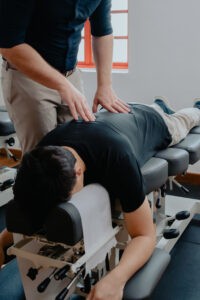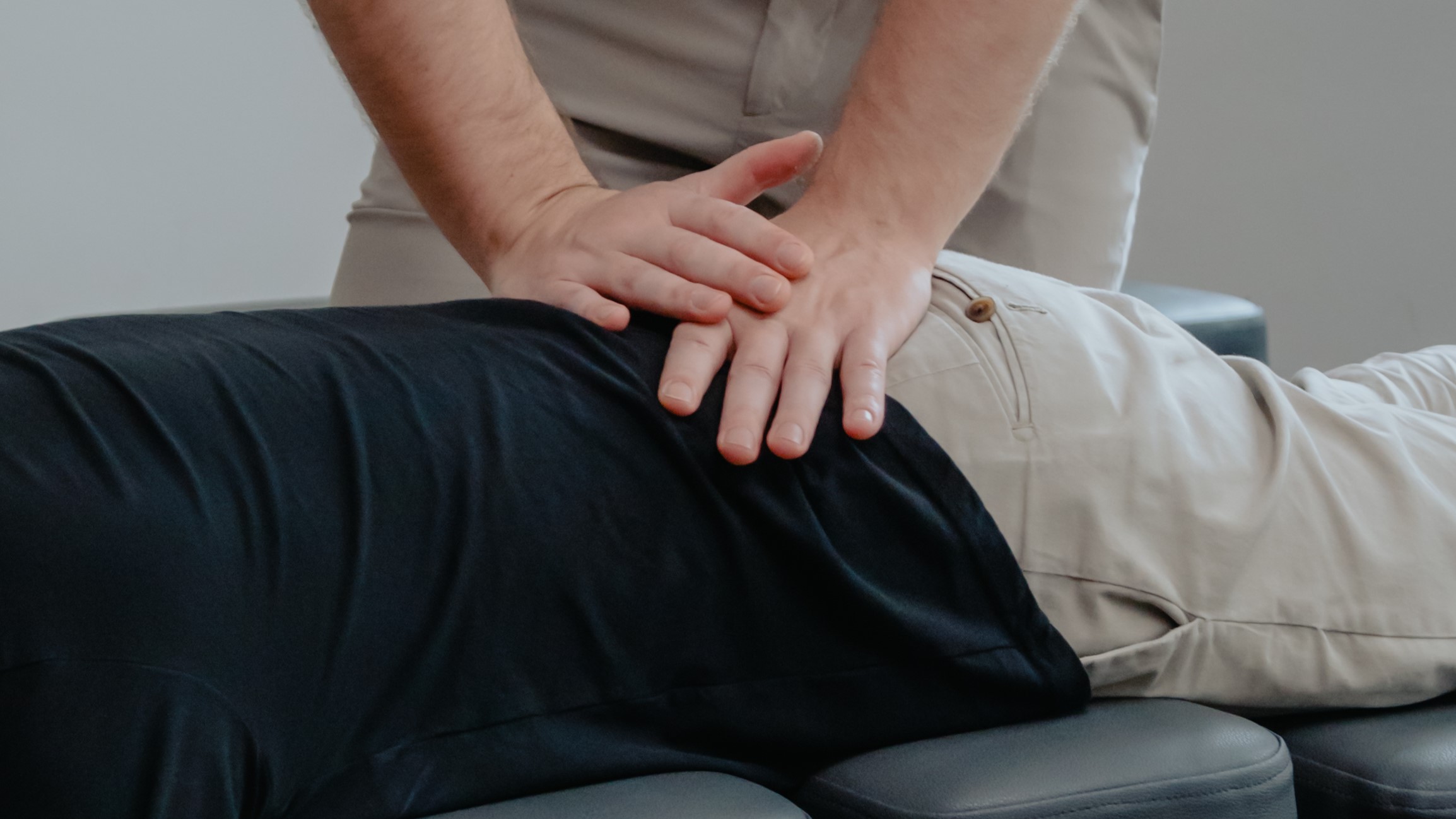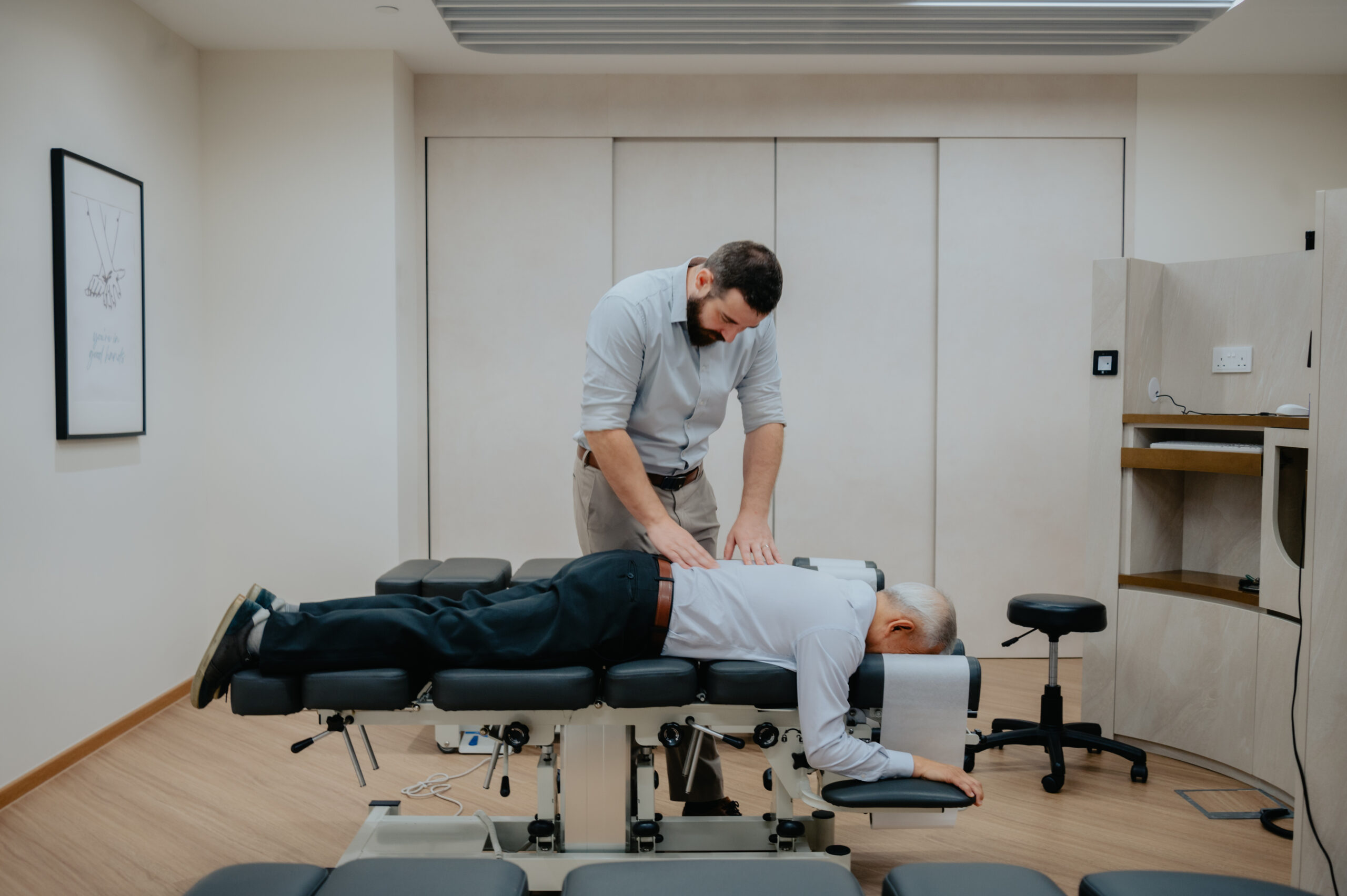If you’ve ever experienced a strange “snap” or “pop” in your hip when moving, you might have encountered Snapping Hip Syndrome. This intriguing condition can be both discomforting and puzzling, leaving many individuals wondering about its causes, symptoms, and potential methods of care. Let’s dive into the world of Snapping Hip Syndrome, explore its origins, discuss the role of chiropractic care, and provide insights into managing and preventing this phenomenon.
What is Snapping Hip Syndrome?

Snapping Hip Syndrome, also known as coxa saltans, is a condition characterised by a snapping or popping sensation in the hip when walking, running, or performing certain movements. This sensation can occur on the outside of the hip (lateral snapping hip) or the front of the hip (anterior snapping hip). While Snapping Hip Syndrome is often not painful, it can still be bothersome and lead to concerns about underlying issues such as lower back pain.
What is External Snapping Hip Syndrome?
External Snapping Hip Syndrome is a specific type of hip discomfort characterised by a distinct snapping or popping sensation during certain movements. This happens because a tough band of tissue in your hip, called the iliotibial band, rubs against a bony bump on your thigh bone. This rubbing, along with the involvement of a big hip muscle called the gluteus maximus, can create a clicking or snapping feeling. You might notice this most when you bend your hip and then straighten it again. While not usually a severe medical condition, it can cause discomfort and impact daily activities.
What is Internal Snapping Hip Syndrome?
Internal Snapping Hip Syndrome presents as an audible snapping or clicking sensation within the hip joint during specific movements. This happens because of the iliopsoas tendon, which is like a strong rope that connects your hip muscles to your pelvis. When you bend and straighten your hip, this tendon can slide over the bony parts inside your hip joint, causing the snapping sensation. This movement and interaction can generate friction, leading to the characteristic snapping sensation. People experiencing internal snapping hip syndrome might notice the sensation during activities like walking, running, or lifting the knee. While not usually a serious medical issue, it can be uncomfortable and impact mobility. Seeking professional evaluation and guidance can aid in managing and alleviating this condition effectively.
Is Snapping Hip Syndrome serious?
Snapping hip syndrome, although typically not considered a serious medical condition, can still be uncomfortable and bothersome for individuals experiencing it. This condition is characterised by a snapping or popping sensation in the hip during movement, often accompanied by mild discomfort. While it may not pose a significant threat to overall health, it can impact daily activities and athletic performance. Seeking professional evaluation from a chiropractor or healthcare provider is recommended to determine the underlying cause and receive appropriate guidance on managing symptoms and improving hip function.
What are the causes of Snapping Hip Syndrome?
Understanding the root causes of Snapping Hip Syndrome involves delving into the anatomy of the hip joint. In some cases, the snapping sensation is caused by a muscle or tendon moving over a bony prominence in the hip joint. This can occur due to tightness in the hip muscles, imbalances in muscle strength, or structural variations in the hip bones. Additionally, inflammation or swelling in the hip joint can contribute to the snapping sensation.
Do anatomical variations contribute to Snapping Hip?
Yes! When individuals possess unique shapes and structures in their hip bones and tendons, it can create an environment where friction and impingement become more likely during hip movements. These variations might involve the size or alignment of the bones, as well as the tension and position of the tendons.
For instance, a slight deviation in the alignment of the hip joint or the presence of bony prominences can lead to increased rubbing between the structures during flexion and extension. These irregularities can make certain individuals more susceptible to the snapping or popping sensations associated with snapping hip syndrome. Chiropractic assessment and intervention can help address these variations, offering tailored solutions to alleviate discomfort and enhance hip functionality.
Do overuse or repetitive movements contribute to Snapping Hip?
Absolutely, overuse or repetitive movements can indeed contribute significantly to the development of snapping hip syndrome. This is especially true for athletes, dancers, and individuals with professions or hobbies involving frequent and vigorous hip motions. The repetitive stress placed on the hip joint during these activities can lead to irritation and strain of the surrounding tissues, tendons, and muscles.
The consistent friction and pressure may exacerbate the chances of the iliotibial band or the iliopsoas tendon snapping over bony structures, resulting in the characteristic sensations associated with snapping hip syndrome. Recognising this risk is crucial for individuals in these fields, as proactive measures such as proper warm-up routines, stretching, and controlled activity intensity can help mitigate the chances of developing this discomforting condition.

Do muscle imbalances contribute to Snapping Hip?
Muscle imbalances play a significant role in contributing to snapping hip sensations. When the
muscles around the hip are imbalanced—either weak or overly tight—it can disturb the harmonious movement of tendons and tissues in the hip region. This disruption can lead to friction, catching, or popping sensations commonly associated with snapping hip syndrome.
Weak hip muscles may struggle to provide adequate stability during movements, while overly tight muscles can alter the biomechanics of the hip, causing uneven forces and tension. Consequently, addressing muscle imbalances through exercises, stretches, and chiropractic care can restore proper muscle function, alleviate discomfort, and promote smoother hip movement, ultimately helping to mitigate the occurrence of snapping hip sensations.
Does injury or trauma contribute to Snapping Hip?
Injury or trauma can indeed contribute to the development of snapping hip syndrome. Previous injuries involving the hip joint or its surrounding structures, such as muscles, tendons, or ligaments, can create imbalances in the biomechanics of the hip. Scar tissue formation, altered muscle mechanics, and changes in joint alignment due to trauma can disrupt the smooth movement of these structures.
As a result, the interaction between tendons, muscles, and bones can be compromised, leading to the characteristic snapping or popping sensations associated with the syndrome. This emphasises the importance of seeking professional evaluation and care, particularly from chiropractors who specialise in musculoskeletal health, to address and rehabilitate past injuries and their potential contributions to snapping hip issues.
Does improper technique contribute to Snapping Hip?
Absolutely, improper technique during exercises or movements can indeed contribute to the development of snapping hip syndrome. Particularly in activities that require frequent hip flexion and extension, such as running, cycling, or weightlifting, using incorrect form can place undue stress on the hip joint and its surrounding structures. When the mechanics of the hip aren’t aligned properly, it can lead to increased friction and irritation, potentially triggering the snapping or popping sensations characteristic of the syndrome.
It’s crucial to prioritise proper form and biomechanics to minimise the risk of developing or exacerbating snapping hip syndrome. Seeking guidance from a chiropractor or a fitness professional can help ensure that movements are performed correctly, reducing the strain on the hip and promoting overall joint health.
In many cases, snapping hip syndrome can be managed and alleviated through conservative approaches such as chiropractic care, physical therapy, and lifestyle adjustments. Consulting a qualified chiropractor or healthcare professional is crucial to accurately diagnose the underlying cause of your snapping hip and develop an effective patient plan tailored to your individual needs. By addressing the root causes, you can find relief from discomfort and improve your hip’s overall function and mobility.
What are the signs of Snapping Hip Syndrome?
The primary sign of Snapping Hip Syndrome is the audible or palpable snapping sensation when moving the hip joint. This sensation might be accompanied by a feeling of the hip “catching” or momentarily getting stuck before releasing. Some individuals may experience mild discomfort, while others might not feel any pain at all.
How do I address my Snapping Hip?

If you’re dealing with a snapping hip, seeking the expertise of a chiropractor can provide valuable insights. Chiropractors are skilled in assessing musculoskeletal issues and can help identify the underlying causes of your snapping hip syndrome. During your consultation, a chiropractor will perform a thorough examination to determine a personalised plan that may include gentle adjustments, targeted stretches, and exercises aimed at improving hip mechanics and addressing muscle imbalances. Your chiropractor may also offer lifestyle recommendations to support your relief, such as proper posture, exercise modifications, and self-care techniques.
It is good to note that every individual’s snapping hip condition is unique, and a chiropractor will craft a personalised plan to address your specific needs. By partnering with a chiropractor, you can take proactive steps toward enjoying improved mobility and comfort.
How can I prevent Snapping Hip Syndrome?
One way to potentially prevent Snapping Hip Syndrome is by considering regular chiropractic care. Chiropractic adjustments can help maintain proper spinal alignment and overall hip joint function. By ensuring that your body’s alignment is optimal, the risk of developing snapping hip syndrome might be reduced, as the mechanics of your hips and surrounding structures are better supported and aligned through the care provided by a chiropractor.
Can a chiropractic session address Snapping Hip Syndrome?
Chiropractic care, while not intended to “cure” Snapping Hip Syndrome, can provide valuable insights and strategies for managing the condition. Chiropractors are trained to assess musculoskeletal imbalances and joint dysfunctions. Through chiropractic adjustments, soft tissue techniques, and lifestyle recommendations, chiropractors can work to improve hip joint function, reduce inflammation, and alleviate muscle tension that might be contributing to the snapping sensation.
What is a Snapping Hip test?
A snapping hip test is a diagnostic procedure performed by healthcare professionals, including chiropractors, to identify the underlying cause of the snapping sensation. During the test, the healthcare provider may ask you to perform specific movements that trigger the snapping sensation. By observing and feeling the movement, they can gather valuable information about the location of the snapping and the structures involved.
What can I expect in a chiropractic session at Chiropractic Singapore?

Here at Chiropractic Singapore, you can expect a comprehensive assessment of your hip joint and overall musculoskeletal health. The chiropractor will likely ask about your medical history, conduct a physical examination, and observe your movements. Based on their findings, they’ll develop a personalised plan that may include gentle adjustments, soft tissue techniques, and exercises to address the factors contributing to your Snapping Hip Syndrome.
How effective are chiropractic sessions in addressing Snapping Hip Syndrome?
The effectiveness of chiropractic sessions in managing Snapping Hip Syndrome can vary depending on the individual, the severity of the condition, and the underlying causes. Chiropractic care focuses on restoring proper joint mechanics, reducing muscle imbalances, and promoting overall musculoskeletal health. While it may not completely eliminate the snapping sensation, many individuals find relief and improved hip function through chiropractic methods.
Other FAQs regarding Snapping Hip
Do I need to undergo surgery for Snapping Hip?
Surgery is typically considered a last resort for Snapping Hip Syndrome and is only recommended when conservative approaches, such as physical therapy and chiropractic care, have not provided satisfactory results. Most cases of Snapping Hip Syndrome can be managed effectively through non-invasive methods.
Will the pain from Snapping Hip Syndrome go away immediately after a chiropractic session?
The response to chiropractic care varies from person to person. While some individuals may experience immediate relief after a session, others might require several sessions to notice significant improvement. Chiropractic care aims to address the underlying factors contributing to the snapping sensation, which can take time depending on the individual’s condition. To know more about what to do before, during and after a Chiropractic session to maximise your results, check out one of our blog posts here!

Is Snapping Hip related to back pain?
While Snapping Hip Syndrome itself is not directly related to back pain, it’s important to note that the hip joint and the lower back are interconnected. Imbalances or dysfunctions in one area can
potentially impact the other. Chiropractors take a holistic approach to musculoskeletal health, considering how various parts of the body interact and influence each other.
What are some Snapping Hip exercises?
Snapping hip exercises are designed to improve hip flexibility, strengthen supporting muscles, and promote proper hip mechanics. Some effective exercises might include hip stretches, leg swings, hip bridges, and clamshell exercises. However, it’s advisable to consult a healthcare professional or physical therapist before starting any exercise regimen, especially if you’re experiencing discomfort or pain.
Address Snapping Hip Syndrome with chiropractic care
In the realm of musculoskeletal discomfort, Snapping Hip Syndrome stands as a unique and intriguing phenomenon that can puzzle and inconvenience individuals. With its distinct snapping or popping sensation during hip movement, understanding its causes and seeking effective care become essential.
Expert insights from the field of chiropractic care shed light on this condition, offering a holistic approach to addressing its underlying factors. Through comprehensive assessments, tailored exercises, and gentle adjustments, chiropractors aim to alleviate discomfort, enhance hip functionality, and improve overall quality of life. While Snapping Hip Syndrome may not be a grave medical concern, the expertise of our chiropractors, coupled with recommended exercises and lifestyle adjustments, can provide a pathway to relief and an opportunity to enjoy pain-free movement and activity.











